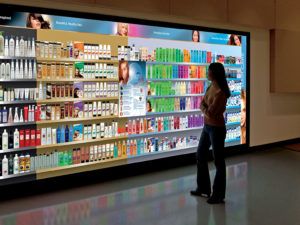P&G: End-to-end Supply Chain Model

P&G has established its competitive edge to lead the global supply chain with the concept of end-to-end model. How does the company leverage digital capability to build its supply chain model?
Emerging Digital Business Models
The past 30 years have been a massive change in P&G’s supply chain operations. Without a doubt, digital technology is being one of the biggest drivers of such transformation. According to Supply Chain 4.0 in Consumer Goods, the focus of the supply chain management role has altered to “advanced planning processes” based more on the actual demand from end consumers enabled by digital analytical forecasting and integrating operations planning. [1] Such demand-driven model, in which sensing and responding to demand as quickly as possible, requires manufactures to reconsider its production to shipment network design. In order to meet such demand, P&G integrated data-driven production flow of operations that significantly improved responsiveness as well as transparency. [2] As a result, the digital pieces of the supply chain that used to be discrete individual steps now become more holistic, real-time management of the entire ecosystem. [3]
End-to-end Supply Chain – From Factory to Shelf
P&G has leveraged large-scale application of advanced analytics and digital technology to excel in its ability to manage complicated global supply chain with more than 130 manufacturing sites serving over 180 countries. One of the key drivers is an “end-to-end model” that connected the siloed steps from suppliers to retailers to provide the most value to the end consumers, “with faster-than-ever response times” [2]. The concept of integrating the whole value chain allow every stakeholders of its eco chain to minimize the unnecessary inventory as well as to speed up the system.
P&G integrates its supply chain software with its suppliers, distributors and retailers with a notion of joint business planning with key stakeholders. [4]. To fully integrate different parts of the chain, understanding that digital automation of workflows that allows high visibility of any movement in each step is a key to enable end-to-end model. Digital automation of workflows empowered by use of algorithm-driven tools to reduce exceptions, enables end-to-end planning, connecting headquarters, manufacturing plants, distributor, and retailers. [2]
One highlight in logistics capability, called “Distributor Connect” connects P&G with distributors. [5] Digitally enabled operational program, it allows all the transportation, from raw materials from suppliers to finished goods to retailers, be accessible in one source of data, on their laptop or mobile, for the supply managers to track the status of the delivery. With enhanced real time visibility of where things move, Distributor Connect significantly reduces inventory across the ecosystem and the ‘deadhead,’ trucks not optimally utilized, by about 15%. [3]
Similarly, not only does P&G support with mobile-phone applications that enable retailers to check the status and order more products, it fully incorporates “GDSN,” Global Data Synchronization Network with the operation with retailers. GDSN enables 100% automated commerce without human intervention. [6] This capability significantly improves the human error between retailers and companies and save cost for all the parties.
Leaping for the next step to enable R&D Lab to Shelf
These ‘end-to-end’ approach, enabled by digital capabilities, allow the company to accelerate the time to deliver its products to the market. However, the implications of rising digitalization trend do not just start from manufacturing. It goes back into product innovation. [8] If we look at different industries, for example apparel industries, digital landscape has pushed each brand to take advantage of latest technology such as AI to realize real-time personalization. [7]
To truly accelerate the cycle of innovation, the company should consider the following:
- Unlocking insights through Advanced Analytics– If we can quickly identify the insights from the big data, could we capture primary demand for the manufacture without sequential researches to ‘qualify’ the products? AI will enable the company to better understand and interpret individual customers’ preferences. This will allow us to shorten the lead-time to explore different options of formulations. This approach will also significantly reduce finished goods inventory with more precise demand forecast while offering the better value proposition to the end consumers.
- Direct to Consumer –one way to shorten the lead time from manufacturing to consumers is to cut some phases of the supply chain. Rather than moving the products from factories to retailers, P&G should accelerate the development of direct to consumer supply chain from the manufacturing plants.

Questions to be answered
As we have better clarity of the current practice with digital capability, P&G will continue to face challenges including the following:
- How could the organization fully integrate the product innovation phase into the end-to-end model to meet the individual needs of end customers?
- How could a company continue to leverage economy of scale while meeting the demand from each retailer just in time?
- As digital technology is constantly evolving, how could P&G stay afloat in such transformation?
(word count: 776)
[1] Alicke, K., D. Rexhausen, and A. Seyfert, “Supply Chain 4.0 in consumer goods,” McKinsey & Company, April 2017, [https://www.mckinsey.com/industries/consumer-packaged-goods/our-insights/supply-chain-4-0-in-consumer-goods], accessed November 2017
[2] Aronow, S., Nilles, K. and Romano, J., “The Gartner Supply Chain Top 25 for 2017”, Gartner Inc., May 25, 2017, [https://www.gartner.com/newsroom/id/3728919], accessed November 2017.
[3] Chui, Michael, “Inside P&G’s digital revolution,” McKinsey Quarterly, November 2011, [https://www.mckinsey.com/industries/consumer-packaged-goods/our-insights/inside-p-and-ampgs-digital-revolution], accessed November 2017
[4] Fritzen, Soren., F. Lefort, O. Lovera-Perez, and F,. Spangar, “Digital innovation in consumer-goods manufacturing,” McKinsey & Company Consumer Packaged Goods Article, November 2016, [https://www.mckinsey.com/industries/consumer-packaged-goods/our-insights/digital-innovation-in-consumer-goods-manufacturing], accessed November 2017
[5] Trebilcock, Bob, “What Does It Take To Remain A Supply Chain Leader?”, SupplyChain247, January 2015, [http://www.supplychain247.com/article/what_does_it_take_to_remain_a_supply_chain_leader], accessed November 2017
[6] Vadino, Jessica, “Digital Transformation in Retail: How to Take Advantage of Innovation”, E-Apparel, June 23, 2017, [https://apparelmag.com/digital-transformation-retail-how-take-advantage-innovation], accessed November 2017
[7] Boudet, Julien., B Gregg, J Heller, and C, Tufft, “The heartbeat of modern marketing: Data activation and personalization,” McKinsey & Company Marketing & Sales, March 2017, [https://www.mckinsey.com/business-functions/marketing-and-sales/our-insights/the-heartbeat-of-modern-marketing], accessed November 2017
[8] O’Mahar, Kevin, “CPG: the Post-Replenishment Supply Chain Challenge,” Logistics & Transportation, Nov 30, 2016, [https://www.forbes.com/sites/kevinomarah/2016/11/30/cpg-the-post-replenishment-supply-chain-challenge/], accessed November 2017.
Photo credits:
Davenport, Thomas H., “How P&G Presents Data to Decision Makers,” Harvard Business Review, April 2013, [https://hbr.org/2013/04/how-p-and-g-presents-data], accessed November 2017
Fritzen, Soren., F. Lefort, O. Lovera-Perez, and F,. Spangar, “Digital innovation in consumer-goods manufacturing,” McKinsey & Company Consumer Packaged Goods Article, November 2016, [https://www.mckinsey.com/industries/consumer-packaged-goods/our-insights/digital-innovation-in-consumer-goods-manufacturing], accessed November 2017




Shoko, I found it very interesting to understand a little better P&G’s supply chain and how they are taking steps to digitize it. I also agree that increasing speed to consumer, visibility and rastreability are key to win in this game. Companies have now the ability to create a digital “twin” of the products they sell and track it throughout its entire supply chain. One question that I have is to what extent is P&G leveraging Internet of Things in their products and whether or not this is even a consideration for them, since some of their products are somewhat commoditized.
Thanks for sharing this CPG example. The idea that P&G can go further in these digitization efforts to eventually cut off parts of the supply chain is intriguing. If this is the case, how and why are their supply chain partners currently collaborating in ongoing digital efforts, if the ultimate result might be to dis-intermediate them? Do you see a future where current supply chain actors remain in a partly digitized world, while P&G pursues a different segment of customers altogether through a P&G-only, truly digital approach? While there likely is enough gross demand to support multiple supply chain types at first, we can imagine that if the direct-to-consumer is superior, the impact of factors such as network effects may favor an winner-take-all shift to that model.
Shoko, thank you for the great insight into P&G’s world renowned supply chain. You addressed many of the aspects I wondered about in my previous career as a Walmart category manager!
The question you brought up about customization in order to meet the individual needs of end customers is particularly salient. The crux of this issue is something we’ve discussed greatly in class recently: network effect and a chicken or the egg situation. Retailers and suppliers both hold an immense amount of rich information, but are often reluctant to share with their partners. Trust needs to be built into these relationships in order to maximize the size of the pie and total potential upside for everyone. Digitization is making this increasingly easier in practice, but time will tell whether the retail and CPG industry titans will be willing to share their “secrets”.
Thank you Shoko for this insightful article about P&G and its supply chain. I think you brought up a very interesting point around ‘Direct to Consumer’ and the possibility that some part of supply chain would be cut out. It is applicable to both how the physical goods get from manufacturing plant to consumer and how the information feedback loop goes back from customer to manufacturers.
I totally agreed with ‘Distributor Connect’ and its benefits to all the parties ‘from factory to shelf’. In addition, we could already see that digitalization has disrupted the industry even further as manufacturers bypassed the ‘shelf’ and went directly to consumers through online platform. Traditional retailers have changed the way they operate as well as their role in the whole supply chain from being the ‘shelf’ to being the ‘logistic guy’ as they moved to online channel. The joint business plan will have to be more rigorous as customers become omni-channel.
One way P&G could do to stay up-to-date with digital transformation is to form strategic partnership with cutting-edge parties in the supply chain. For example, it joined with Amazon to introduce P&G’s brand dash button where consumers have the button at home and place their orders when they are running low on specific consumable products. This is extremely convenient for customers and also gives a real-time order transparency right from the consumers – one step beyond the transparency at retailers.